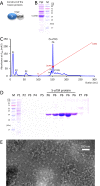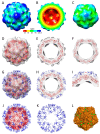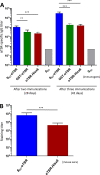The αTSR Domain of Plasmodium Circumsporozoite Protein Bound Heparan Sulfates and Elicited High Titers of Sporozoite Binding Antibody After Displayed by Nanoparticles
- PMID: 37312932
- PMCID: PMC10259582
- DOI: 10.2147/IJN.S406314
The αTSR Domain of Plasmodium Circumsporozoite Protein Bound Heparan Sulfates and Elicited High Titers of Sporozoite Binding Antibody After Displayed by Nanoparticles
Abstract
Introduction: Malaria is a devastating infectious illness caused by protozoan Plasmodium parasites. The circumsporozoite protein (CSP) on Plasmodium sporozoites binds heparan sulfate proteoglycan (HSPG) receptors for liver invasion, a critical step for prophylactic and therapeutic interventions.
Methods: In this study, we characterized the αTSR domain that covers region III and the thrombospondin type-I repeat (TSR) of the CSP using various biochemical, glycobiological, bioengineering, and immunological approaches.
Results: We found for the first time that the αTSR bound heparan sulfate (HS) glycans through support by a fused protein, indicating that the αTSR is a key functional domain and thus a vaccine target. When the αTSR was fused to the S domain of norovirus VP1, the fusion protein self-assembled into uniform S60-αTSR nanoparticles. Three-dimensional structure reconstruction revealed that each nanoparticle consists of an S60 nanoparticle core and 60 surface displayed αTSR antigens. The nanoparticle displayed αTSRs retained the binding function to HS glycans, indicating that they maintained authentic conformations. Both tagged and tag-free S60-αTSR nanoparticles were produced via the Escherichia coli system at high yield by scalable approaches. They are highly immunogenic in mice, eliciting high titers of αTSR-specific antibody that bound specifically to the CSPs of Plasmodium falciparum sporozoites at high titer.
Discussion and conclusion: Our data demonstrated that the αTSR is an important functional domain of the CSP. The S60-αTSR nanoparticle displaying multiple αTSR antigens is a promising vaccine candidate potentially against attachment and infection of Plasmodium parasites.
Keywords: Plasmodium; S60 nanoparticle; malaria; malaria vaccine; norovirus; receptor binding domain; αTSR domain.
© 2023 Xia et al.
Conflict of interest statement
Ming Tan has a financial interest in the S particle vaccine platform technology that Cincinnati Children’s Hospital Medical Center licensed to Blue Water Vaccines, Inc. The authors report no other conflicts of interest in this work.
Figures









Similar articles
-
A Nanoparticle Comprising the Receptor-Binding Domains of Norovirus and Plasmodium as a Combination Vaccine Candidate.Vaccines (Basel). 2025 Jan 1;13(1):34. doi: 10.3390/vaccines13010034. Vaccines (Basel). 2025. PMID: 39852813 Free PMC article.
-
Pseudovirus Nanoparticles Displaying Plasmodium Circumsporozoite Proteins Elicited High Titers of Sporozoite-Binding Antibody.Vaccines (Basel). 2023 Oct 27;11(11):1650. doi: 10.3390/vaccines11111650. Vaccines (Basel). 2023. PMID: 38005982 Free PMC article.
-
Structure of the Plasmodium falciparum circumsporozoite protein, a leading malaria vaccine candidate.J Biol Chem. 2009 Sep 25;284(39):26951-63. doi: 10.1074/jbc.M109.013706. Epub 2009 Jul 24. J Biol Chem. 2009. PMID: 19633296 Free PMC article.
-
Current Challenges in the Identification of Pre-Erythrocytic Malaria Vaccine Candidate Antigens.Front Immunol. 2020 Feb 21;11:190. doi: 10.3389/fimmu.2020.00190. eCollection 2020. Front Immunol. 2020. PMID: 32153565 Free PMC article. Review.
-
Pathogen-binding nanoparticles to inhibit host cell infection by heparan sulfate and sialic acid dependent viruses and protozoan parasites.Smart Med. 2024 Mar 1;3(2):e20230046. doi: 10.1002/SMMD.20230046. eCollection 2024 Jun. Smart Med. 2024. PMID: 39188697 Free PMC article. Review.
Cited by
-
A Nanoparticle Comprising the Receptor-Binding Domains of Norovirus and Plasmodium as a Combination Vaccine Candidate.Vaccines (Basel). 2025 Jan 1;13(1):34. doi: 10.3390/vaccines13010034. Vaccines (Basel). 2025. PMID: 39852813 Free PMC article.
-
Pseudovirus nanoparticles targeting the receptor binding HA1 domains of influenza viruses elicited high HA1-specific antibody responses and protected mice against mortality caused by influenza virus challenges.Vaccine. 2025 Feb 6;46:126585. doi: 10.1016/j.vaccine.2024.126585. Epub 2024 Dec 7. Vaccine. 2025. PMID: 39648102
-
Pseudovirus Nanoparticles Displaying Plasmodium Circumsporozoite Proteins Elicited High Titers of Sporozoite-Binding Antibody.Vaccines (Basel). 2023 Oct 27;11(11):1650. doi: 10.3390/vaccines11111650. Vaccines (Basel). 2023. PMID: 38005982 Free PMC article.
References
-
- World Health Organization. World Malaria Report 2021. World Health Organization; 2022.
-
- World Health Organization. World Malaria Report 2019. World Health Organization; 2019.
MeSH terms
Substances
LinkOut - more resources
Full Text Sources

